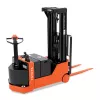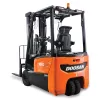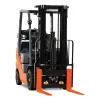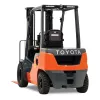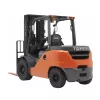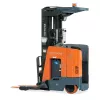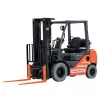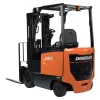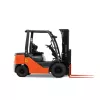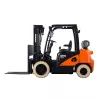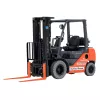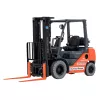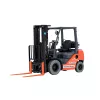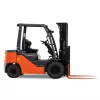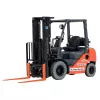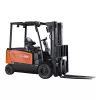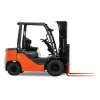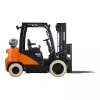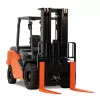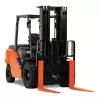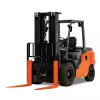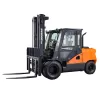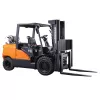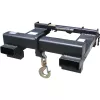Más información sobre los montacargas
Puede confiar en los alquileres de montacargas de United Rentals para su sitio o instalación. Independientemente de que tenga que mover o elevar materiales sobre suelo firme o en terrenos escabrosos, tenemos montacargas confiables para ayudarle. Además de ofrecer una amplia selección de montacargas de fabricantes de confianza como Case, SkyTrak, Toyota, entre otros, United Rentals también facilita recursos valiosos para ayudarle a elegir el montacargas adecuado para sus necesidades. Si no está seguro sobre qué tipo o tamaño de montacargas es mejor para su proyecto, consulte nuestro artículo de Project Uptime Tamaños de montacargas: qué saber sobre los tipos, las capacidades y las dimensiones. Este recurso puede ayudarle a tomar una decisión informada y garantizar que tenga el equipo adecuado para el trabajo. Nuestra flota de montacargas en alquiler incluye montacargas de alcance, montacargas de almacén y montacargas para terrenos escabrosos. Todos vienen en configuraciones eléctricas, a gasolina o diésel. Consulte nuestro artículo de Project Uptime sobre la gestión eficaz de flotas.
Para obtener más información sobre nuestra selección de montacargas en alquiler, consulte nuestra sección de preguntas frecuentes a continuación.
Los montacargas a diésel son los más adecuados para proyectos y sitios de trabajo al aire libre. Los motores a diésel tienen emisiones de escape que podrían ser potencialmente peligrosas y afectar negativamente la salud de sus trabajadores. Las emisiones de escape diésel son gases y vapores tales como óxido nitroso, dióxido de nitrógeno, dióxido de azufre y monóxido de carbono, así como partículas finas conocidas como DPM (materia particulada diésel).
El peso del montacargas depende en gran medida de su tipo, tamaño y configuración. Un montacargas de 5,000 libras de capacidad puede pesar hasta 7,000 libras con carga y combustible. United Rentals puede ayudarle a seleccionar el montacargas adecuado para las necesidades de su sitio, instalación y tarea.
Sí, un operador de montacargas debe tener una licencia válida para usar un montacargas en cualquier sitio de trabajo en los EE. UU. United Rentals ofrece capacitación y certificaciones de operadores de equipos a quienes lo necesitan. Lea nuestro artículo de Project Uptime, Introducción a la seguridad de montacargas.
Montacargas de almacén
Los montacargas de almacén son mejores para levantar y transportar cajas, palés y otros materiales en distancias cortas. Como su nombre lo indica, a menudo se usan en almacenes para cargar y descargar inventario, así como para recoger y apilar. Pueden manejar cargas pesadas y operar sobre superficies interiores o superficies exteriores lisas.
Los montacargas de almacén vienen en diferentes tipos. Si necesita mover cargas hacia un lado, busque un cargador lateral o un montacargas de almacén con una conexión de desplazamiento lateral disponible. Un apilador a pie es un montacargas con conductor a pie diseñado para mover y apilar palés a mayores alturas que una transpaleta estándar. Para lograr el mayor alcance, elija un montacargas con mástil de cuatro etapas.
Manipuladores telescópicos
Para elevar materiales del suelo a una altura de hasta 115 pies, necesitará un manipulador telescópico, también conocido como “montacargas telescópico” o “montacargas de alcance”. A diferencia de un montacargas tradicional, un manipulador telescópico tiene un brazo telescópico para elevar materiales y puede usarse para extender cargas por encima de obstáculos. El brazo puede equiparse con varias conexiones, como una conexión de gancho de grúa o una cubeta para material. Los manipuladores telescópicos más grandes con capacidades máximas de 10,000 lb y más tienen estabilizadores para estabilizar la máquina para elevar cargas más pesadas más alto.
Montacargas de mástil recto para terreno escabroso
Si moverá materiales sobre superficies irregulares o escabrosas, es posible que necesite un montacargas para terreno difícil, popular en obras industriales y de construcción en exteriores. Estas máquinas son adecuadas para usar en superficies irregulares, escabrosas, suaves, arenosas o con lodo. Para obtener tracción adicional en lugares de trabajo con lodo, considere alquilar un montacargas para terreno difícil con tracción en las 4 ruedas.
Elija un montacargas con capacidad máxima suficiente y asegúrese de que se adapte a donde lo necesite.
Piense en qué materiales pretende elevar (¿palés individuales? ¿contenedores pesados? ¿madera?) y las cargas más pesadas que necesitará levantar. Es común que las personas subestimen la capacidad del montacargas que necesitan; por lo tanto, si tiene dudas, alquile un montacargas grande. En el caso de montacargas con brazos telescópicos, consulte la tabla de carga para averiguar la capacidad de carga del montacargas.
Además de la capacidad, también deberá considerar las dimensiones del montacargas en relación con las restricciones de espacio del sitio de trabajo. Por ejemplo, si está trabajando en un almacén, conocer el ancho de los pasillos o las dimensiones comunes de los palés ayudará a determinar el tamaño y el tipo de montacargas para alquilar. Las transpaletas y los cargadores laterales son ideales para pasillos estrechos.
La altura a la que necesita elevar materiales determinará no solo qué tipo de montacargas necesita alquilar, sino también el tipo de mástil que necesita (recto o extensible y cuántas etapas). Los mástiles del montacargas suelen ser de dos o tres etapas, aunque algunos son de cuatro etapas (mástiles cuádruples). Los mástiles de cuatro etapas están diseñados para el apilado más alto.
Recuerde tener en cuenta el espacio libre superior, incluidas las puertas, y asegúrese de que el mástil (o el brazo en el caso de un manipulador telescópico) quepa a su altura más baja. Los mástiles de cuatro etapas se pliegan a una altura más baja que otros mástiles.
Si va a trabajar en interiores, un montacargas eléctrico, alimentado por baterías recargables, puede ser una buena apuesta. Son silenciosos y no producen emisiones. Cuesta más que otros modelos, pero también le ahorran una cantidad considerable de combustible. Por supuesto, tendrá que tomarse el tiempo para recargar la batería. Un montacargas de GLP (gas propano líquido) puede operar en interiores o exteriores. Los montacargas a diésel, por lo general, se reservan para uso en exteriores, aunque las máquinas más nuevas con motores de nivel 4 pueden usarse en interiores debido a sus bajas emisiones.
La mayoría de los montacargas están diseñados para un tipo específico de rueda, por lo que es probable que, si está usando el montacargas adecuado para el terreno, este tenga las ruedas adecuadas.
Las ruedas neumáticas, con aire comprimido, pueden usarse en terrenos escabrosos y superficies irregulares, incluidas las que se encuentran en sitios de construcción y en depósitos madereros. Los montacargas con ruedas neumáticas, por lo general, están diseñadas para trabajos en exteriores, aunque también pueden ser útiles en grandes almacenes. Las ruedas macizas, fabricadas con caucho sólido, proporcionan menos tracción y menos espacio libre desde el suelo y están diseñadas para pisos interiores y superficies exteriores lisas y niveladas.
Glosario de montacargas: terminología, repuestos, clasificaciones
Consulte a continuación las definiciones útiles de los términos de los montacargas, los detalles sobre los repuestos de los montacargas y las especificaciones de los montacargas que debe conocer para encontrar el mejor alquiler de montacargas para sus necesidades.
La capacidad de carga del montacargas es una especificación crucial para elegir el montacargas adecuado. El fabricante determina la capacidad, lo que indica la cantidad máxima de peso que el montacargas elevará a una altura de horquilla predeterminada en un centro de carga especificado. El centro de carga más común es de 24 in.
Clase I: los montacargas eléctricos de clase I, o camiones manuales, son óptimos para las industrias de almacenamiento general, incluidas la venta minorista, el almacenamiento y la manufactura de alimentos, y son populares para uso en interiores.
Clase II: los montacargas de clase II permiten maniobrabilidad en espacios interiores estrechos y son ideales para almacenar inventario. Los tipos incluyen seleccionadores de existencias, montacargas telescópicos y camiones de torreta.
Clase III: los montacargas de clase III, que suelen usarse para transferir palés o carritos a montacargas alternativos, incluyen transpaletas eléctricas, apiladores y tractores de remolque.
Clase IV: los montacargas de clase IV, también conocidos como camiones con ICE (motor de combustión interna), tienen neumáticos sólidos/con amortiguación a prueba de perforaciones diseñados para uso en interiores. Estos montacargas funcionan con diésel o gas de petróleo líquido.
Clase V: los montacargas de clase V, similares a los montacargas ICE de clase IV, son más versátiles, lo que permite el uso en interiores y exteriores. Están equipados con neumáticos diseñados para superficies escabrosas y terrenos exteriores.
Clase VI: los montacargas de clase VI consisten en tractores de remolque eléctricos y de combustión interna, y remolcan el producto en lugar de levantarlo. Se usan con frecuencia en aeropuertos y en líneas de ensamblaje.
Clase VII: los montacargas de clase VII operan a diésel y están diseñados para terrenos escabrosos. Se usan regularmente al aire libre, en madereras y sitios de construcción.
Un contrapeso de montacargas aprovecha el peso adicional en el chasis (generalmente, el contrapeso o contraequilibrio se encuentra en el extremo opuesto de las horquillas) para contrarrestar una carga contra la línea central de las ruedas motrices. En algunos tipos de montacargas, como los manipuladores telescópicos o montacargas de alcance, los estabilizadores actúan como contrapeso/contraequilibrio. Los estabilizadores son “pies” extensibles que se extienden y hacen contacto con el suelo, lo que proporciona estabilidad para cargas pesadas.
La placa de datos o placa de calificación de un montacargas es una lámina, montada en el cuerpo del montacargas, en la que figura información vital del montacargas, como la capacidad de carga, los tipos de combustible, el número de serie y la altura del montacargas. Por lo general, la placa de datos se puede encontrar en el panel de instrumentos, cerca de los controles hidráulicos. Es importante que los usuarios del montacargas estén familiarizados con la placa de datos, ya que enumera importantes limitaciones del producto y requisitos de mantenimiento. El término “placa de datos” a menudo puede usarse indistintamente con términos como placa de capacidad, placa de peso y placa de identificación.
La altura de elevación libre es la altura máxima a la que puede elevar las horquillas antes de cambiar la altura del mástil. Es bueno estar al tanto de esta especificación cuando se trabaja en un edificio con techos bajos o un remolque.
Un cilindro de elevación del montacargas es el mecanismo hidráulico que eleva y baja las horquillas. Es un mecanismo de acción única, lo que significa que solo se mueve en una dirección.
La MFH (altura máxima de las horquillas), también llamada “altura máxima de elevación” o “altura del mástil”, es la altura máxima que alcanzarán las horquillas cuando el mástil haya alcanzado su extensión completa.
El centro de carga de un montacargas está entre la base de las horquillas y el centro de gravedad de la carga. Determina la cantidad y distribución del peso en la plataforma elevadora. El centro de gravedad del montacargas cambia en función de si el elevador está cargado, y el centro de carga, al sostener el producto, ayuda a determinar el punto de pivote del elevador. Si bien el centro de carga de un montacargas varía, los palés suelen tener un centro de carga de 24 in si la longitud del palé es de 48 in de largo.
Hay varios factores que considerar al elegir entre los diferentes tipos de montacargas. Entre esos factores se encuentran los diferentes tipos de mástiles y qué tipo de mástil de montacargas se adapta mejor a sus necesidades. El mástil es el componente vertical que permite que el montacargas eleve y baje su carga. Los mástiles pueden tener diferentes cantidades de secciones que se extienden, desde una sola etapa hasta cuatro. Los mástiles de una sola etapa tienen un canal y carecen de capacidades de elevación libre. La elevación libre describe cuando las horquillas de elevación pueden elevarse o bajarse sin manipular los canales del mástil. Los mástiles de dos etapas (o dúplex) permiten el doble apilamiento y pueden elevarse libremente. Los mástiles de tres etapas, los más comunes, permiten un mayor alcance debido a sus tres etapas. Estos también se denominan “mástiles de tres etapas” o “tríplex”. Los montacargas de mástil cuádruple tienen cuatro juegos de rieles móviles, que permiten un alcance de 22 ft.
Las ruedas con amortiguación están hechas de caucho sólido colocado alrededor de un anillo de metal. Son de menor mantenimiento, tienden a ser más baratas y permiten radios de giro más pequeños, lo que las hace ideales para espacios pequeños. Debido a su acabado suave, las ruedas con amortiguación tienen dificultades en terreno escabroso, pero funcionan muy bien en superficies más lisas, en interiores o exteriores.
Las ruedas neumáticas están llenas de aire o son sólidas. Las ruedas neumáticas permiten una tracción más fuerte, que funciona mejor para terrenos escabrosos y exteriores. Existen dos tipos distintos de ruedas neumáticas: sólidas y llenas de aire. Los neumáticos sólidos están completamente hechos de caucho, mientras que los neumáticos llenos de aire tienen capas de caucho con aire en el medio. Si bien las ruedas con amortiguación también están completamente hechas de caucho, las ruedas neumáticas sólidas tienen un espacio libre más alto y surcos más profundos.
Si opera en superficies lisas en espacios pequeños, las ruedas con amortiguación son la opción ideal. Permiten la maniobrabilidad dentro de su sitio. Si opera en un espacio con muchos clavos o metales, use ruedas neumáticas sólidas que no puedan perforarse, lo que promueve una mayor productividad. Si trabaja en superficies irregulares y agrestes, los neumáticos llenos de aire proporcionan una conducción más fácil con mayor tracción. Su área de trabajo le ayudará a determinar la mejor opción para sus necesidades.
Los dientes u horquillas estándar de los montacargas miden 4 ft, desde el extremo de la punta hasta el vástago, pero los dientes también pueden medir 6 ft u 8 ft. El tamaño de los dientes depende de la clasificación y capacidad del montacargas.
Montacargas en acción








